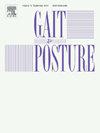Step-time variability is a specific gait characteristic associated with functional disabilities in knee osteoarthritis: The Nagahama study
IF 2.2
3区 医学
Q3 NEUROSCIENCES
引用次数: 0
Abstract
Background
Gait characteristics of spatiotemporal parameters of knee osteoarthritis (OA) using large sample of patients with various radiographic severities and asymmetry have not been studied previously.
Objective
This study aimed to determine the disease-specific gait characteristics of knee OA and assess the spatiotemporal gait parameters associated with functional disability.
Method
The data was extracted from the Nagahama study and included 1591 participants aged ≥ 60 years, who underwent knee radiography and gait analysis. Of these, 998 (62.7 %) were assigned to healthy control group and 593 (37.3 %) to knee OA group. Gait speed, cadence, stride length, step length asymmetry, and step-time variability were measured using wearable inertial sensor. The Knee Scoring System (KSS) was used to assess functional disability. Logistic regression analysis was performed, with group variables as dependent variables and gait parameters as independent variables. In knee OA group, multiple regression analysis was performed with KSS score as dependent variable and gait parameters as independent variables after adjusting for potential confounders.
Results
Step-time variability was associated with knee OA (adjusted odds ratio [OR], 1.08; 95 % confidence interval [CI], 1.00–1.15; p = 0.037). Lower gait speed (Beta [B]=13.60; 95 %CI, 4.41–22.80; p = 0.004) and higher step-time variability (B=-0.82; 95 %CI, −1.40 to −0.24; p = 0.005) were associated with a decrease in KSS score in knee OA.
Conclusion
These findings suggest that higher step-time variability is a specific gait characteristic of knee OA and is a negative factor associated with functional disabilities. The assessment of step-time variability is a useful indicator for screening abnormal gait patterns in knee OA.
步长变异性是与膝骨关节炎功能障碍相关的特定步态特征:Nagahama研究
本研究旨在确定膝关节OA的疾病特异性步态特征,并评估与功能障碍相关的时空步态参数。方法数据来自Nagahama研究,共纳入1591名年龄≥60岁的参与者,他们都接受了膝关节放射摄影和步态分析。其中,998人(62.7%)被分配到健康对照组,593人(37.3%)被分配到膝关节OA组。使用可穿戴惯性传感器测量步速、步幅、步长、步长不对称和步时变异性。膝关节评分系统(KSS)用于评估功能性残疾。以群体变量为因变量,步态参数为自变量,进行了逻辑回归分析。在膝关节 OA 组中,以 KSS 评分为因变量,步态参数为自变量,在调整潜在混杂因素后进行多元回归分析。较低的步速(贝塔[B]=13.60;95 %CI,4.41-22.80;p = 0.004)和较高的步时变异性(B=-0.82;95 %CI,-1.40 至-0.24;p = 0.005)与膝关节 OA 的 KSS 评分下降有关。步时变异性评估是筛查膝关节 OA 异常步态的有用指标。
本文章由计算机程序翻译,如有差异,请以英文原文为准。
求助全文
约1分钟内获得全文
求助全文
来源期刊

Gait & posture
医学-神经科学
CiteScore
4.70
自引率
12.50%
发文量
616
审稿时长
6 months
期刊介绍:
Gait & Posture is a vehicle for the publication of up-to-date basic and clinical research on all aspects of locomotion and balance.
The topics covered include: Techniques for the measurement of gait and posture, and the standardization of results presentation; Studies of normal and pathological gait; Treatment of gait and postural abnormalities; Biomechanical and theoretical approaches to gait and posture; Mathematical models of joint and muscle mechanics; Neurological and musculoskeletal function in gait and posture; The evolution of upright posture and bipedal locomotion; Adaptations of carrying loads, walking on uneven surfaces, climbing stairs etc; spinal biomechanics only if they are directly related to gait and/or posture and are of general interest to our readers; The effect of aging and development on gait and posture; Psychological and cultural aspects of gait; Patient education.
 求助内容:
求助内容: 应助结果提醒方式:
应助结果提醒方式:


